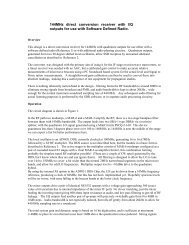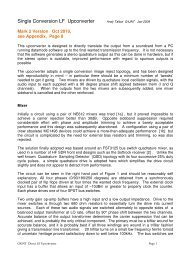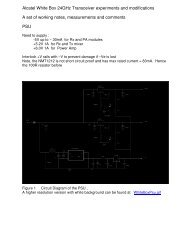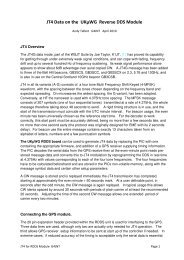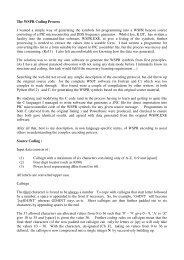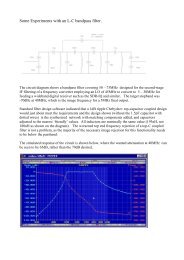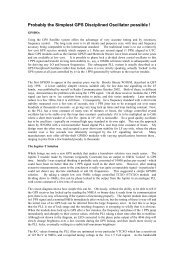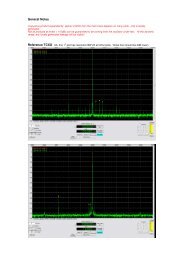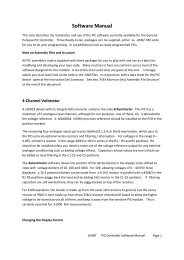The JT4 Coding Process (Plain Text messages only) - G4JNT
The JT4 Coding Process (Plain Text messages only) - G4JNT
The JT4 Coding Process (Plain Text messages only) - G4JNT
You also want an ePaper? Increase the reach of your titles
YUMPU automatically turns print PDFs into web optimized ePapers that Google loves.
Adding 32768 or setting bit 15 of N3 is the plain text flag<br />
<strong>The</strong> contiguous 72 bit sequence is made up of N1 * 2 (16 + 28) + N2 * 2 16 + N3<br />
In GEN<strong>JT4</strong>.BAS the data is represented in a string format from this point on.<br />
31 zero bits are added at the end to make a 103 bit sequence for the next stage.<br />
Convolutional Encoding<br />
<strong>The</strong> data is now expanded to add FEC with a rate ½, constraint length 32, convolutional encoder.<br />
<strong>The</strong> 103 bits (including trailing zeros) are read out MSB first:<br />
(using the string representation, one-at-a-time from the left hand end)<br />
<strong>The</strong> bits are clocked simultaneously into the right hand side, or least significant position, of two 32<br />
bit shift registers [Reg 0] and [Reg 1]. Each shift register feeds an Exclusive-OR parity generator<br />
from feedback taps described respectively by the 32 bit values 0xF2D05351 and 0xE4613C47.<br />
Parity generation starts immediately the first bit appears in the registers (which must be initially<br />
cleared) and continues until the registers are flushed by the final 31 st zero being clocked into them.<br />
Each of the 103 bits shifted in generates a parity bit from each of the generators , a total of 206 bits<br />
in all. For each bit shifted in, the resulting two parity bits are taken in turn, in the order the two<br />
feedback tap positions values are given, to give a stream of 206 output bits.<br />
<strong>The</strong> parity generation process is :<br />
Shift the next source bit into the LSB of both [Reg 0] and [Reg 1],<br />
moving the existing data in each one place left<br />
Take the contents of [Reg 0]<br />
AND with 0xF2D05351<br />
Calculate the single bit parity (XOR) of the resulting sum.<br />
Append to the output data stream<br />
Take the contents of [Reg 1]<br />
AND with 0xE4613C47<br />
Calculate the single bit parity (XOR) of the resulting sum.<br />
Append to the output data stream<br />
<strong>The</strong> expansion from 72 source data bits to 206 has added sufficient redundancy in an optimised<br />
manner to give a code capable of very strong Forward Error Correction against random errors.<br />
Interleaving<br />
Errors over a radio link are rarely random , being more likely to occur in bursts against which this<br />
sort of convolutional coding is less effective,. So the final stage of encoding is to mix up, or<br />
interleave. the 206 data bits so as to move adjacent bits away from each other in time. <strong>The</strong> result is<br />
that close-together bits corrupted by burst interference are spread throughout the frame and therefore<br />
appear as random errors – which the FEC process can cope with.



